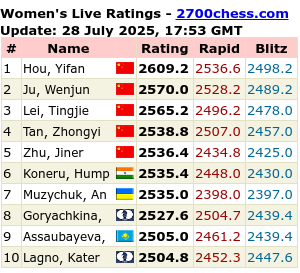21 August 2011, Kuala Lumpur – Here is an article written by WIM Iryna Zenyuk on endgames for chess.com. Practical advice on proper endgame techniques in winning chess games.
“The two endgames presented today are from my own practice. They happened in the recent Cleveland Open in the last two rounds. My friend made a joke saying that I steer the games into endgames in order to have material for my endgame column. He has some point as recently my play features a higher than normal number of endgames. I will try to give an explanation here. As you focus on some parts of the game (in my case endgames) you become more confident in them and are more willing to play them. However, in the first example I was ready to get the point immediately and go home rather than play an endgame. During the game I had very few minutes on the clock to complete 10 moves.
In mutual time trouble Jayakumar complicated matters in a losing position, and his decision payed off as I didn’t figure out the right solution at the board. Rh1 is threatened with a checkmate and if I prevent it with Kg1 then Bh2+ followed by Bf4 – a draw did not satisfy me after having an extra piece. What other options does white have in this position? To give the king an escape square either the g3 pawn or the bishop on e2 has to move. After g3 the rook on e1 is not defended, so we eliminate this move and are left with just 8 bishop moves.
At first I thought that Bh5 is winning as it blocks the h-file and after R:h5 I can capture the bishop on f4, however black has a nice perpetual check construction: after Rh1+ there is Nc3-Nb1 checks and my king cannot step away from the rook because it is undefended. My next thought was to cover the b1 square with the bishop so there would be no Nb1+ and due to time scarcity I had to settle on this 2nd decision, which turned out to be not the best one. Only 1 out of 8 bishops moves leads to direct victory – all the others give white a slight advantage, can you figure out which move is winning?
We still had 3 moves until time control having about 1 minute each but the position significantly simplified which allowed us to find moves rather easily. Here, I was really upset at how the events developed. Let us recap what had happened. White was winning after Bf3, however I did not find the move and had to settle for this position, which is objectively still better for white. It is nice to be better but not to be better after you were winning.
Normally, I would be so upset as to throw the game away, however this time curiosity won out over sadness. The endgame looked very interesting to me during the game and I thought that there is a positive side to ending up in this position as I can learn more about two pieces vs. rook endgames.
Because my king is active I should be better even after the a2- pawn will fall. Where do you think the king should go – to the queenside to pick up the a and b- pawns or to the kingside where it will defend the g and f- pawns? During the game I led my king to the queenside, which allowed black immediately to create a passed pawn on the kingside.
Instead, the bishop should go to a4 to block the a5- pawn and protect the b3 pawn , the knight should go to c6 to pick up the a5 and later the b4- pawns and the king should stay on f4 to prevent the passed-pawn formation on the kingside. This is a good example of how to think schematically.
The game went for 6.5 hours and the result was a draw. Going into the last round I had 3 out of 4 and had to win to at least get the 2nd place in the tournament. I was paired against a player around 2170, having black and facing the Sicilian. The previous game drained me and there was little time to recover. I decided to try to recover during the opening stage by playing something familiar and delaying the fight for the late middlegame/endgame. I spent less than 5 minutes to reach the following position after the 16th move.
This is the critical position as f5 is a dangerous move to play. I thought it is a pure speculation during the game as I couldn’t find an advantage in any of the lines that I looked at. This move opens up the position which should benefit the side with the bishop. It creates weaknesses on h7, f5 and e6, e7. The plusses of the move are the weakness on d5 and the f6-square for the king. During the game I saw the right defense for white after which my position becomes worse but I saw many ways where white can go wrong. I took the risk and was lucky enough to get away with it.
I think that white made one mistake (23.f4) in the game that led to a position where he had to find precise moves (26.a4 line) to hold the game.
On the other hand, if he found the Bd3-Kd4 set-up I would have been the one looking for precise moves. The game landed me in a tie for the 1-3rd places (and 1200$ prize) in the Cleveland Open.
Going for an endgame in a critical game when one has to win at all cost is always an option, as long as your technique is good and you remain optimistic and willing to play a long grinding game.”
(written by WIM Iryna Zenyuk for chess.com)































No comments:
Post a Comment